In
this first lab you will be introduced to the computing environment in
the Baldy 21 lab. If you are familiar with Unix you may know how to do
some or all of the following tasks. Do them all the same. If
you are new to Unix, these exercises will get you up and running with
most of the tools you need to successfully complete the lab assignments
of this course. Some further tools will be introduced as we need them
in later labs.
You should not expect to finish all of these
exercises during the allotted lab time. You should plan to return to
the lab during open lab hours (hours when the lab is open but there are no formal labs scheduled) to complete your work.
Read
through the entire lab before you start working, so that you know what
to expect. Make sure you save your work often, and keep track of what
you are expected to submit.
The
objective of this lab is to introduce you to the Unix operating system
and some of the tools available to you so that you can work on the labs
independently.
Your instructor has briefly gone through the tasks listed below during lecture to help prepare you for this lab. You must now carry out each of the following tasks on your own in the lab setting. Chapter references are to the Unix book you should have brought with you to the lab.
Logging in - Connecting to the system
Your
first lab task is to log in to your CSE computer account. Your CSE
account is valid on the computers in Baldy 21. This account is separate
from your UBUnix account.
-
If
you have not had a CSE account previously, your login name is the same
as your UB-IT name. Your password is the same as your UB-IT password
was at the time when your CSE account was created.
-
If
you have previously had a CSE account (e.g. if you took any other CSE
course last year where you received an account), your login name and
password should not have changed.
Unix is the name of the operating system
that is running on the machines in the Baldy 21 lab. An operating
system (or OS) provides basic services to both programs (applications)
running on the machine and to users who are working on the machine.
Examples of services provided by an OS are a facility to read the
contents of a file from a disk, or run multiple programs at one time
(multi-task).
Gnome is a windowing system, or graphical user interface (GUI), to the underlying Unix operating system. Gnome is thus separate from the operating system. A windowing system manages windows on a screen and provides a graphical way of interacting with the operating system.
On
personal computers it is becoming more and more difficult to
distinguish between the operating system and the windowing system as they
are becoming more tightly integrated. In the Unix world however, the
separation is still clear and it is not uncommon for different users on
a given system to use different window systems.
To log in:
- You should see a welcome screen with a place for your username.
Enter your username (UB-IT name), and then press OK.
- You will then be asked to enter your password. Enter your password,
and then press OK.
When Gnome is finished loading, you will
be presented with a desktop. There will be a few icons on it that looks like this:

There is a panel across the top of the screen which has two menus on it. This is similar to the Start Menu feature of Microsoft Windows. There is also a panel along the bottom of the screen. If you want to know what anything does, hover your mouse over it and a little description will appear.
In case of emergency where you suddenly need
to leave, such as your grandmother dying (it happens a lot in this class),
let's discuss how to log out of the system before we go any further.
- Just click on the "Actions" on the panel at the top of the screen, then select
"Log Out".
You will probably receive a message asking if you're sure you want to log out. There's also a checkbox that says "Save current setup". If you want to save
your setup (whatever that means), check this box. Then click on "OK" and you
will be logged out. Remember to never leave the lab without logging out, even if it is "just for a minute"!
Spend a moment getting comfortable with Gnome.
To move a window with a title bar (for example double click on 'Computer' to get a window),
click and hold the left mouse button in the middle of the title bar and
drag it to a new position. If you click on the small buttons in the title
bars of the windows, different things will happen:
-
The rightmost button on the title bar:
Left-clicking this will close the window. Try it out: open a window and close it.
The button to the left of that (in the middle
of the three):
Clicking this will toggle the window between "maximized" and "unmaximized"/"normal" modes. In maximized mode, the window will take up the full space of the screen. In normal mode, the window is not necessarily the full size of the screen and you have the ability to move it around and see other things on the screen as well. Try maximizing and unmaximizing some window.
-
The button to the left of that (the left side
of the three):
Left-clicking on this will minimize the window. It keeps the program
running but hides it from view. Now we need to get it back. Just click on the corresponding item on the panel along the bottom of the screen.
-
The button on the far left of the title bar:
Clicking on this will bring up a menu of different things you can do
to the window. Try it out and see what can be done.
As previously mentioned, Gnome is just a
windowing system that interacts with the underlying Unix operating system.
To interact directly with Unix, we need what is called a terminal.
Here are two ways to bring up a terminal in Gnome:
- Right click on an empty space on your desktop and select "Open Terminal"
from the menu.
- Click on the Applications menu on the panel at the top of the screen.
Click on "System Tools", then click on "Terminal".
The terminal window will look like this:
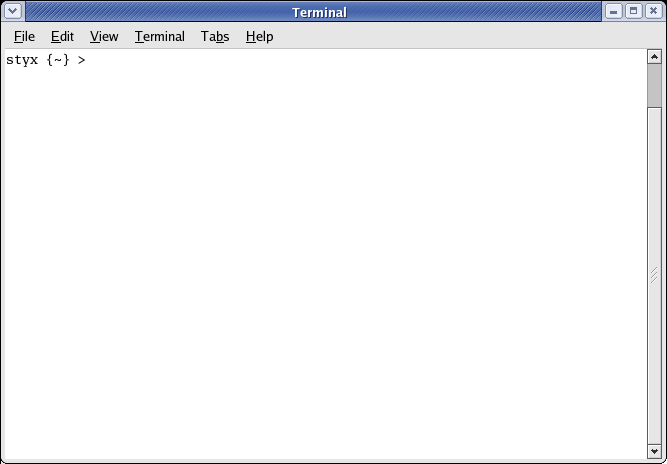
The > symbol is called a prompt. You will type
commands into the prompt to get the Operating System to perform various
tasks for you.
Adding the ampersand (&)
to the end of a Unix command makes it run in the background. When a
command runs in the background (as opposed to the foreground) you get
the Unix prompt back so you can type another command if you wish to. In
this way you can multi-task (have several applications running at once)
without needing a terminal for each application.
The files which you create are stored on a machine called a file server,
which is accessible from all of the workstations in the lab. In other words,
it doesn't matter which workstation you log in at, you will be able to
access exactly the same files. The computer which you will use in the Baldy
21 lab is called styx.cse.buffalo.edu, or just styx for
short. This computer shares its files with several systems, one of which
is called pollux.cse.buffalo.edu (pollux for
short), which you can log into from other places around campus. If you want to work on the CSE servers from the residence halls or off campus, log in to yeager.cse.buffalo.edu.
Changing your Password
It
is a good idea to change your password from your default password to
something else. You should change your passwords often to help keep
your account secure. You must never share your account password with
anyone (including your friends and classmates). Read the section in
Chapter 1 (pages 11-12) about changing your password. Passwords can
only be changed while logged into hadar.cse.buffalo.edu. This is the only operation that you should do while logged into hadar. The rest of your work for this class should be done logged directly onto your machine. Do this now:
To log into hadar, at a prompt type:
ssh hadar
If you receive a message starting with "The authenticity of hose 'hadar (128.205.32.1)'..." type "yes" (without quotes) and hit enter. Ignore the warning that comes up. Then it will ask for your password by saying:
username@hadar's password:
where
'username' is your account name. Type your CSE account password. Nothing will show up, not even asterisks, this is normal. Hit enter and you are now logged on to hadar.cse.buffalo.edu.
Follow the instructions in the book on how to change your password.
Note: it may take a few minutes for the password change to work. This
is normal. When you are done changing it, then type 'exit' at the
prompt, and you will see:
Connection to hadar closed.
Because your CSE account is separate from your UBUnix account, changing the
password on one account does not automatically change the password on
the other. You should change passwords on both accounts on a regular
basis.
Unix and utilities
In this section,
you will experiment with some basic Unix commands, and learn a little
bit about the way in which Unix organizes its file system.
Basic Unix directory structure
Like most file systems, Unix's is tree-structured. The root of the file system is named '/'. As a user on the system you have a home directory,
where all your files are stored. Unix has a "shortcut" to represent
your home directory. This shortcut is the tilde (~). Whenever you want
your home directory, you can just type ~. To find out where your home
directory is, type
echo ~
When I do this, I find out that my home directory is /home/csefaculty/adrienne. This means that my home directory adrienne is located in the subdirectory csefaculty, which is a subdirectory of home, which is an immediate subdirectory of the root directory (which is, as mentioned above, designated by '/'). "/home/csefaculty/adrienne" is a path
which describes how to get from one directory (in this case the root
directory) to another (in this case my home directory). A path can
either be absolute (starting at /) or relative (starting at the current directory).
Every directory has two special entries, . and .. The entry . refers to the directory itself, and .. and refers to the directory's parent directory (i.e. the directory of which this one is an immediate subdirectory). The . and the .. are "shortcuts" as well. No matter where you are, if you want to use your parent directory, then you just use ...
The
root directory is the only directory in the file system which does not
have a parent directory. (Actually, this is not quite accurate. If you
inspect the root directory you will find that there is a .. entry. The parent of the root directory turns out to be the root directory itself!)
Running a Program on Unix
At the prompt, type the command /projects/CSE115/Setup/115setup . This command runs a script on the Unix system that does a number of things behind the scenes to get you set up to work on the labs. The one thing that you can immediately notice is the creation of a file called cse115.epf in your home directory. This file will be used when we start developing programs. However, after you type the command and press Enter, you simply get the prompt back. How would you ever know that this file was created? Well, read on and we will see how to navigate the Unix system's file structure to find the file cse115.epf .
Getting started with Unix
Below I have listed some basic Unix commands. Read the description of each, and carry out any exercises given.
-
ls - This command gives a listing
of the files in a directory. Without any arguments, it provides a
listing of the files in the current directory, and is therefore
equivalent to
ls .
If you specify a directory using a path, ls will respond with a listing of the contents of the specified directory.
Try typing ls at the Unix prompt. When you do, you should notice the file named cse115.epf . There may be other files in your directory as well. If you do not see the file named cse115.epf in your directory, you need to run the /projects/CSE115/Setup/115setup command again.
-
cd
- This command changes the current directory. Without any arguments, it
changes the current directory to your home directory, and is therefore
equivalent to
cd ~
If you specify a directory using a path, cd will set the current directory to the specified directory. One neat thing is that using .. as an argument to cd moves you to the parent directory. More examples of using cd are found on pages 15-16.
-
Using wildcards - Wildcard characters are used in patterns to match filenames. For example, the wildcard character ?
matches any single character. Another wildcard that will be useful is
the * this character, which matches multiple characters. Page 21
of the Unix book gives some more examples on the use of wildcards.
-
man - The man command brings up a manual page (help screen) for a specified command. Let's get the man page for the finger command by typing man finger. More examples for man are given on pages 26-27 of the Unix book.
Directories and files
Next is a list of some fundamental commands which allow you to
manipulate and organize files in a Unix file system. Read the
description of each, and carry out any exercises given.
-
mkdir - This command creates the specified subdirectory. Follow the example on pages 30-31 to make your own subdirectory named NewDirectory.
-
cp - This command copies a file to a new location, leaving the original unchanged. Type
cp NewDirectory temp
How many files does ls report now? Look at the examples on pages 34-35 for more ways to use cp.
-
More fun with ls - Pages 36-37 talk about the different ways you can use ls
to get different information about files. Figure 2.1 on page 36 will
help those who have not used Unix before understand what gets displayed
to the screen when you type ls -l at the prompt.
-
mv - This command moves a file from one location to another. But beware,
because of the way file systems work, moving a file is very similar to renaming. The mv
command is also the rename command. For example we can rename the file called temp by:
mv temp notsotemp
Now you can move the file into the directory we created:
mv notsotemp NewDirectory
A directory is just a special type of file to Unix, so we can rename the directory we just
created before by moving it to a new location. Type
mv NewDirectory MyDir
to rename the directory. Now type ls to see what has happened. See the examples on page 38.
-
rm - The command rm removes a file.
Type rm -i temp followed by ls. How many files does ls
report now? Read more about rm on pages 39-41.
-
rmdir - This command removes the specified subdirectory. Type
rmdir myDir. Read pages 42-43 for more examples of removing directories.
-
find and ln - The sections on find and ln are interesting to read about -
especially when you are looking for a file and can't remember which directory it is in.
Read pages 44-50 for more information about these two commands.
The command shell
Chapter 3 of the Unix book talks about shell command interpreters (often referred to as just shells).
You interact with the shell when you type commands at the prompt. You
should read this chapter. It is important to know that there are
different shells available and understand what some of the differences
are amongst these various shells. This chapter also leads nicely into
Chapters 8, 9 & 10 that deal with running and writing basic
programs that can work with the shell and also with configuring the
shell. These topics are a little more advanced than you need for this
course. When you are ready to delve deeper into the world of Unix these
chapters are a good place to start.
Creating a file
Chapter
4 of the Unix book mentions two editing programs you can use to create
and edit files. This semester, we will develop our Java files in an
editor called Eclipse, which is an environment designed specifically
for creating programs. However, it has the ability to create files that are not
related to programming. (If you have Eclipse installed on a Windows machine,
you can edit Word and Excel documents using Eclipse!) In this exercise we
will use Eclipse to create a simple text file. In the rest of the labs
this semester, we will use Eclipse to create our programs.
Web browser
The next thing you might want to do is start a web browser. The web browser installed on these systems is Firefox. Start the firefox web browser by selecting "Applications" from the panel at the top of the screen. Then select "Internet" and then "Firefox Web Browser":
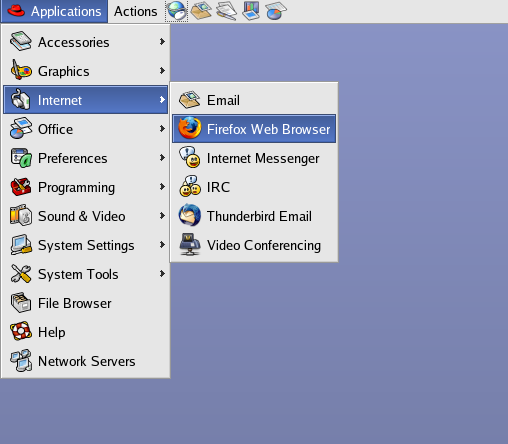
When you first start firefox, you might get a window that looks like this: 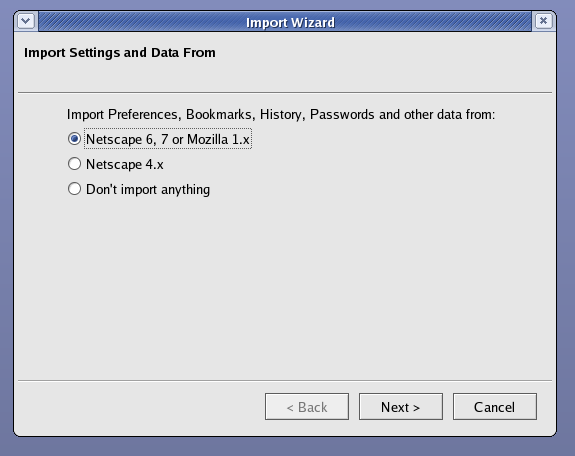
Just click on "Next >", then in the following window, click "Finish".
Navigate to the course website at http://www.cse.buffalo.edu/faculty/adrienne/SP2008/cse115, and browse around to get a feel for the types of information available to you. You are expected to check the main page of the web site for announcements on a regular basis. Note that this lab assignment (and all future lab assignments) is available from the course website.
Setting up Eclipse so you can work on the rest of the labs
Create a directory in your home directory named cse115.
Change directories into that directory (using cd).
Make a directory named workspace.
Now you need to open Eclipse. There are a few ways in which you can do this. You can type the command to launch the program into the prompt. That command is /util/eclipse/eclipse &
This is perhaps a bit tedious, we will show you how to make a "shortcut" for this command a little later in this lab, but for right now, you should consider making a shortcut on your desktop for Eclipse. To do this:
Right click on your desktop and get the following menu. Select Create Launcher:
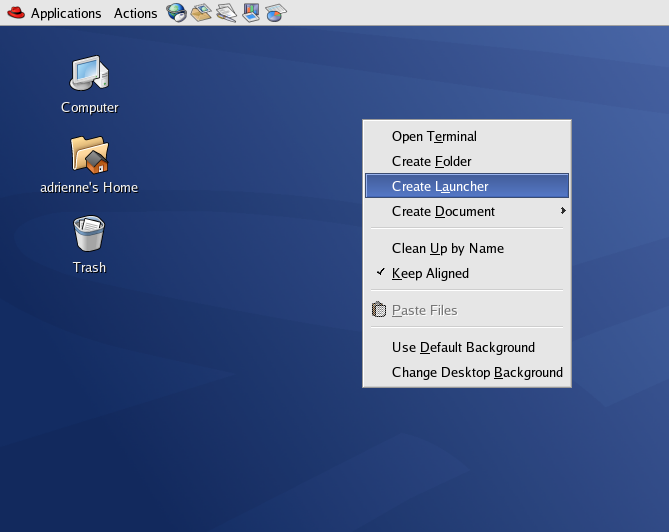
Then you will get the Create Launcher dialog. Make your Dialog look like the one below and click "OK":
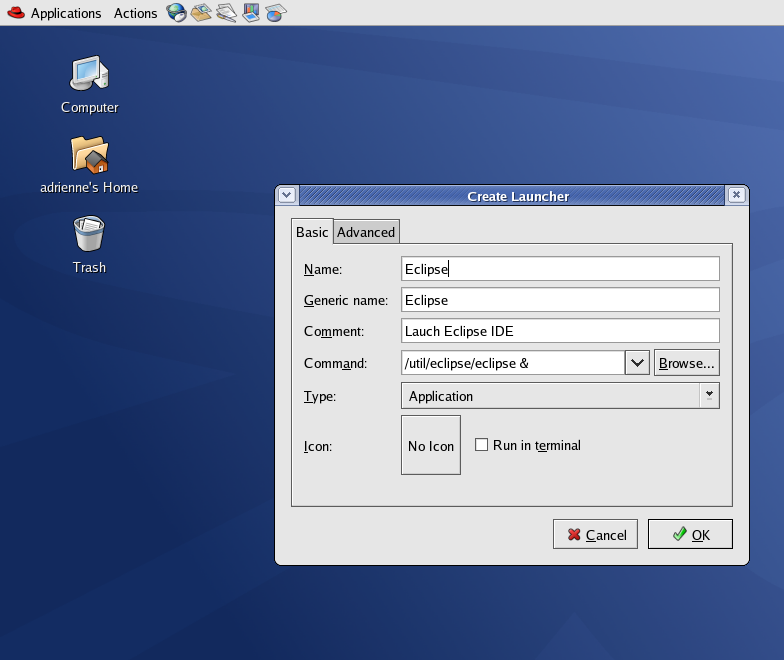
Now you will see an icon on your desktop for Eclipse. You can double-click on it to run Eclipse.
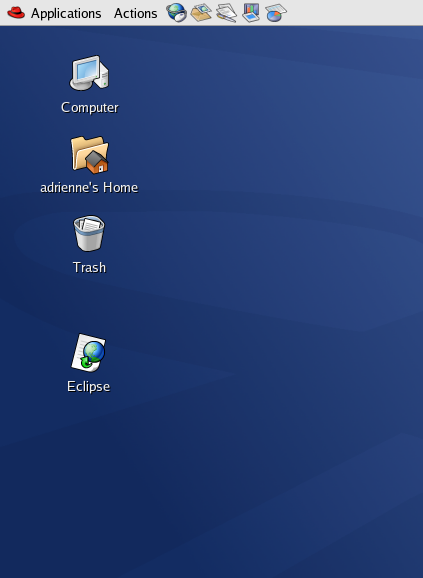
When you start up Eclipse, you will see the following screen:
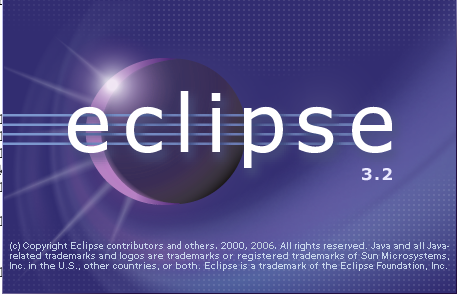
Then you will see a Window that will ask you which workspace you want to open. By default, it will probably say something like this:
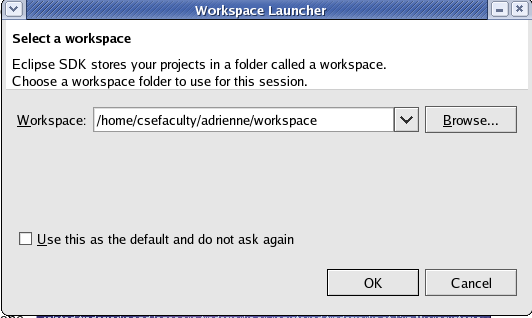
You do not want to use this default workspace. Use the Browse button to make the workspace point to the directory you just made named workspace, like this:
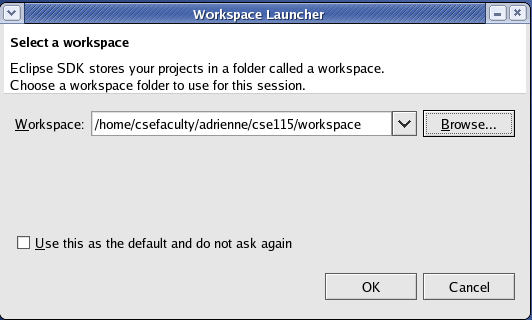
Be sure to check the box "Use as default and don't ask me again", and then click "OK".
You will then see a screen that looks like this. You will choose the arrow to take you to the Eclipse workbench.
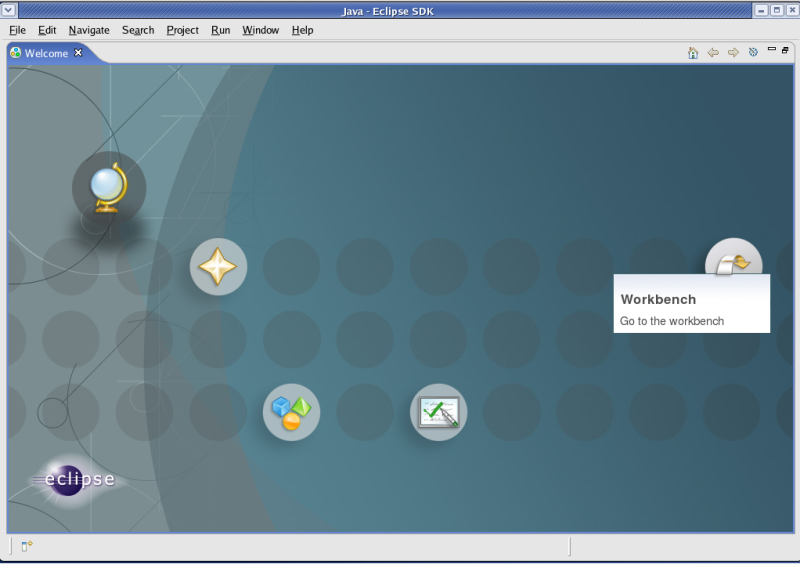
You will then see the default workbench setup. The TAs will talk about customizing this and changing it around throughout the semester. You don't ever have to customize the Eclipse workbench, but we have some suggestions for making life easier when working on projects for this course.
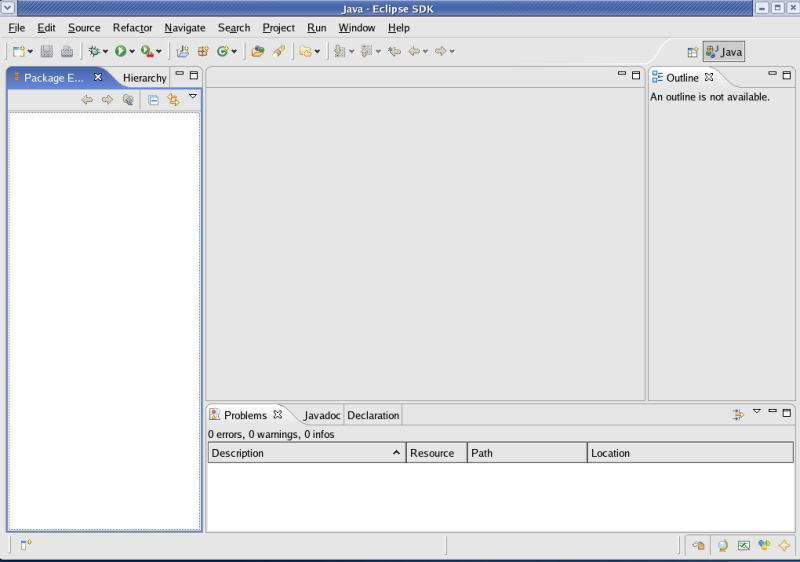
Import preferences file
Next you need do tell Eclipse a few things about how you want it to behave. This is a one-time process. In other words, once you have successfully carried out these steps you will NOT need to repeat them in lab.
Earlier while working on this lab, you ran a script from the prompt. This script put a file in your home directory named cse115.epf. You should check to see that this file is in your directory by typing ls again. If you do not have the file, you should run the script again by doing the following:
At the prompt, type /projects/CSE115/Setup/115setup and hit Enter. After you do this, the file named cse115.epf should be in your home directory.
To import the file, you will first need to open the Import dialog. Do this by selecting "Import..." from the "File" menu. It is common practice to abbreviate menu selections that you need to make in instructions like these. For example, we can abbreviate
select "Import..." from the "File" menu
by simply writing
"File" -> "Import". This time we'll show the screen shot of the menu item being selected, but from now on we'll simply write menu selections using this abbreviated method. Your teaching assistant can help you if you have trouble locating the correct menu selections.
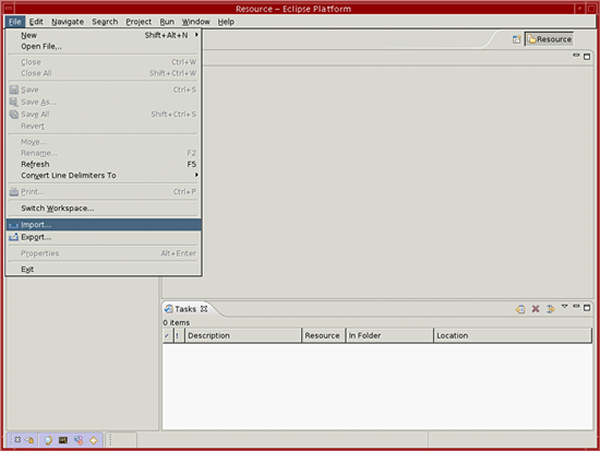
An "Import" dialog window should appear.
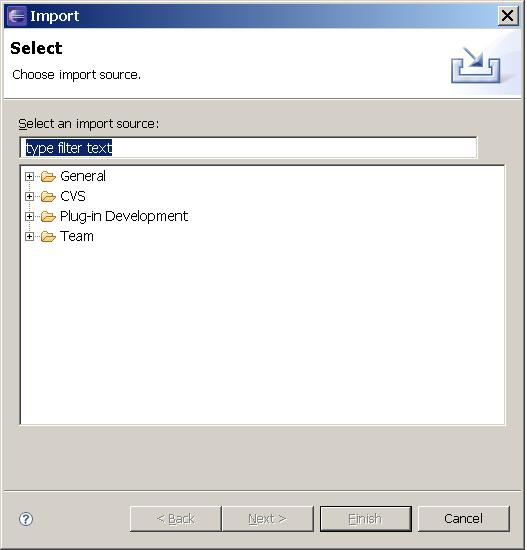
Select the + sign (or the > symbol depending on your OS) and expand the "General" Folder. Note that there is now an option for t "Preferences", as below. Select it and then click "Next".
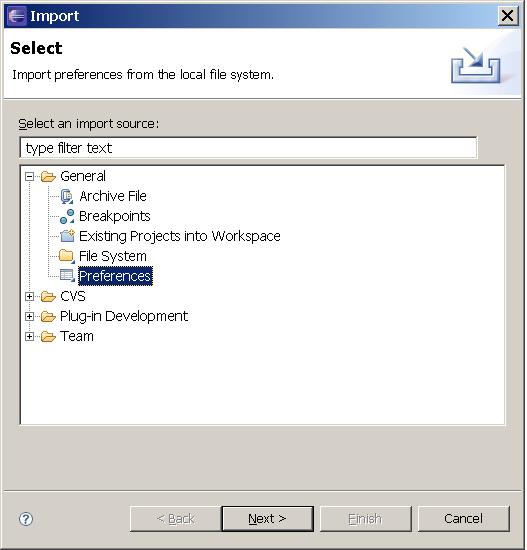
This opens up an "Import Preferences" dialog window. Browse to the file cse115.epf in your home directory and select it.
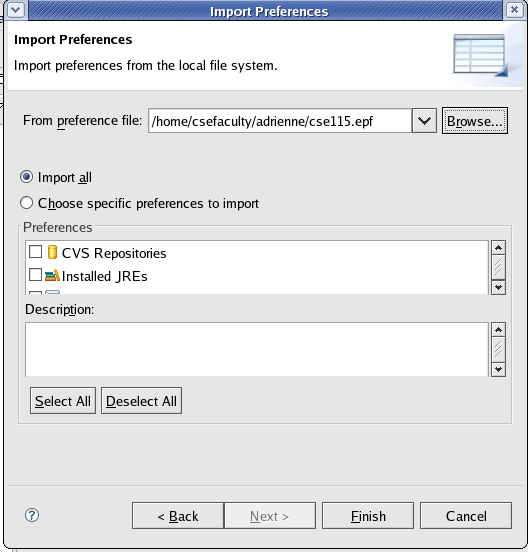
The rest of the options should be OK as they are (they should be as in the screenshot above - if not, make them the same). Click "Finish".
Seeing the connections to code repositories
If you do not have a tab in the lower portion of your screen that says "CVS Repositories", you should open that View so that you can see what Repositories you have connections to. To do this, select Window -> Show View -> Other. You should then select to expand the entry for CVS and select CVS Repositories and click OK. You will now see a view tab on the bottom of your screen that shows which repositories you have access to:

Notice that in the repositories tab, you will see repositories for the lecture code that your instructor has been working on in class as well as the code you will need for the assignments this semester. At any time, you can view any of the code we have been using in class.
Make local plug-ins available
We want to work with the same tools in the lab as we have been using in the classroom. In order to do this, we need to make our UML tool (Green) and the Dr. Java plugins available to our Eclipse session. To do this, go to "Help" -> "Software Updates" -> "Manage Configuration".
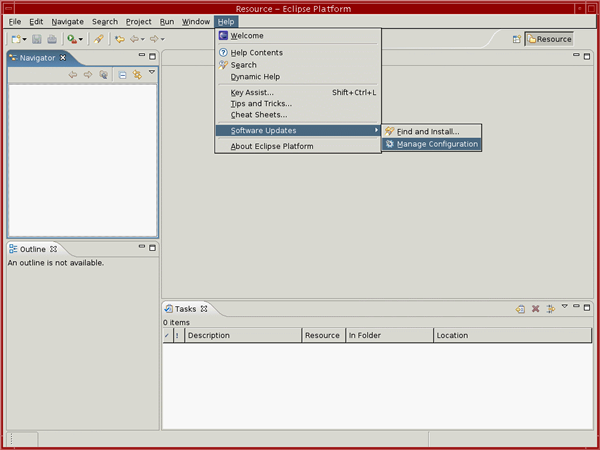
This will open up the "Product Configuration" window.
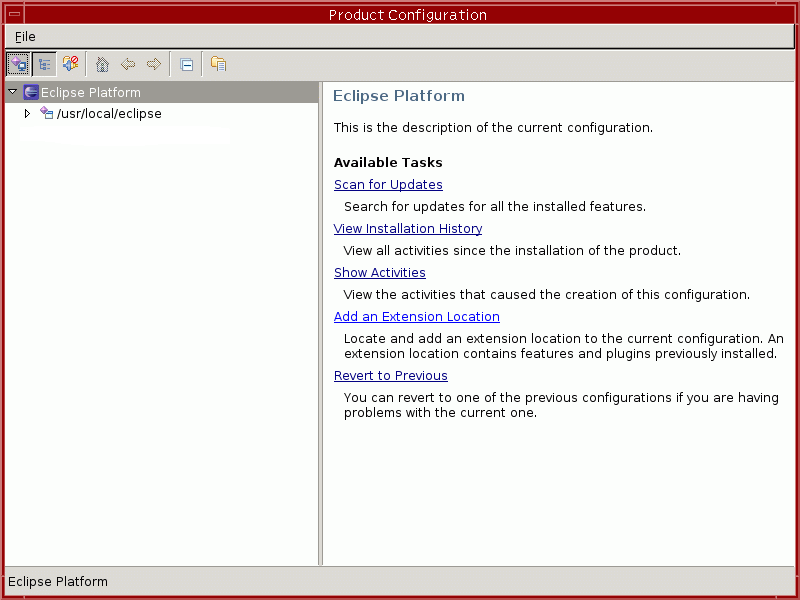
Select "Add an Extension Location" from the right-hand window. You will see the following window:
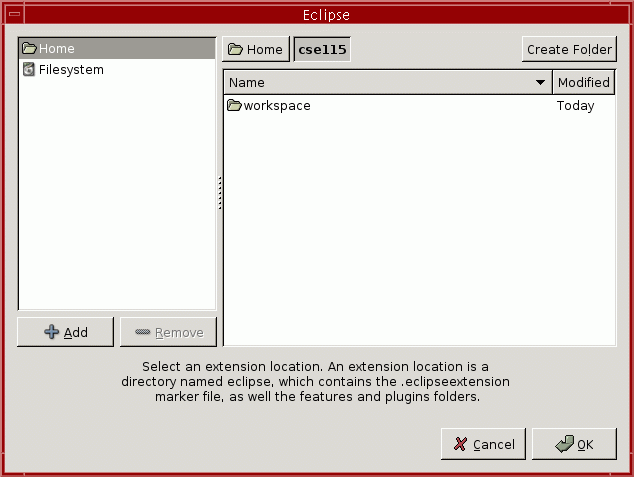
Click on "Filesystem" in the left-hand pane and browse to /projects/CSE115/eclipse
Once you've done this, click "OK". After you click "OK" Eclipse will ask whether to restart the workbench:

Click "Yes" to restart the workbench. When you do, your Eclipse window will disappear for a little while, then Eclipse will start up again.
To make sure you have set this up correctly, you should start up the Dr. Java Interactions pane. To do this, select Window->Open Perspective->Other... This will open the "Open Perspective" dialog window. Select "DrJava" and click "OK". If everything is installed correctly, you should have the DrJava "Interactions Pane" along the bottom of your Eclipse window, and inside the "Interactions Pane" you should see the following text:
Welcome to DrJava.
>
If you encounter problems, ask your recitation TA for help.
Exercise 1 (35%)
Using the rm command without the -i flag can lead to disasterous results, especially if you execute the command and have a typo. Suppose you wanted to delete all files with the file extension .txt (rm *.txt), but when you typed the command, you accidently typed rm * and now you have deleted all the files in the directory, including the files for the project that is due in 15 minutes for CSE 115!
To help avoid these calamities, we are encouraging you to alias the rm command to actually execute the rm -i command. This way, the system will prompt you to ensure that you really want to delete the files you requested. You can read about the alias command on pages 190-191 of the Unix book. Note, however, that for our systems you format your alias command like this (note that this is different than the book):
alias rm 'rm -i'
The general form of the command is alias alternateName actualName
You can alias as many commands as you wish, but for the purposes of the exercise, we are most concerned with you alias-ing the rm command. You will do this by creating a file named .alias, then opening the file using Eclipse's text editor.
Eclipse likes to keep files that you create from scratch in a "project". You will learn how to create a project in Eclipse a bit later on this semester. For now, it will be easier if you create an empty file named .alias in your home directory, and then modify that file using Eclipse's text editor. Here's an easy way to create a new and empty file named .alias in your home directory:
touch ~/.alias
Run Eclipse. Use File->Open File... to browse to and open the .alias file you created in your home directory. You will need to right-click in the filename list and select "Show Hidden Files" to show also those files whose names begin with "." (the so-called "hidden files"). You may also want to click on the "Home" icon in the far upper left corner of the "Open File" dialog (this is not the same as the "home" that might appear above the file list, but the one that is above the "Desktop" icon) to get the file list to show the files in your home directory.
Files whose names begin with a period, like .alias and .cshrc , are called "hidden files" because by default the ls does not display them. The reason is that these files are typically configuration files which most users do not need to worry about. However, if you want ls to show you all files, you should use the "-a" option, as in
ls -a
You can place any aliases that you wish to create for yourself in this file. Save this file.
Next, create a backup of your .cshrc file by copying the file to a file named .cshrcBack. Creating a backup copy of a system file is always a good idea before attempting to modify it. This way, if you do not like the settings you changed or if you broke something, you can simply revert back to the original settings before the changes.
Now open the original .cshrc file in the Eclipse text editor ( File->Open File... ), selecting "Show Hidden Files" again, and then browse to the file. Once your .cshrc file is opened, type the following at the bottom of the file:
source ~/.alias
Save and close the file. Next time you log into styx, your aliases will take effect.
You might also want to create an alias for Eclipse at this point. You will be using Eclipse a lot this semester and a shortcut to starting up the program is nice. Also, it will be of benefit if you stop by office hours or are working from home. You can add the following to your .alias file:
alias eclipse '/util/eclipse/eclipse &'
Now when you want to run Eclipse, you can simply type eclipse at the prompt.
E-mail
Since you have a UB-IT account (i.e. an ACSU or UBUnix account) you also have an e-mail address @buffalo.edu. You cannot receive e-mail at this account until you enable it (even though you can send e-mail from this account without needing to do anything special). You should have enabled your UBUnix e-mail account before coming to your lab session. If you have not already enabled this e-mail account, do so now by visiting http://mailcluster.acsu.buffalo.edu/newuser.html, entering your UB-IT name and clicking the "Submit" button.
The CSE e-mail system is separate from the main UB e-mail system. You can choose to maintain two separate and parallel e-mail systems for yourself (make sure you read e-mail at both sites). An alternative is to designate one as your primary e-mail system, and to forward your e-mail from your secondary e-mail service to your primary. When you account was created, it automatically forwards your CSE email to your UBUnix account. If you would like to maintain two separate email accounts, just delete the .forward file in your home directory.
If you coose to maintain two separate email accounts, you can use Thunderbird to read your email. The information you will need to setup Thunderbird is located here.
Exercise 2 (30%)
Send an e-mail to the grading TA for the course (Ran Xu: ranxu@cse.buffalo.edu). Make sure you send a copy to yourself by including your e-mail address in the list of recipients in the "To:" or the "CC:" line. It is strongly suggested that you use UBMail. The email should be received from your buffalo or CSE mail address, no other email addresses will be accepted. (Resist most strongly the urge to send a copy of this e-mail to your lecture instructor or the teaching TA that is in the lab with you now.) The subject of your e-mail must be: `CSE 115: Lab 1 your name and person number'. For example, `CSE 115: Lab 1 Frodo Baggins 13572468'.
The contents of your message should describe, in 50 words or less, why you want to take CSE 115. You should also create an attachment to this email that is the file you created named .alias that contains your defintion of the rm alias and any other aliases you wished to create. In order to do this, you must manually type in the location of the .alias file (remember it is in your home directory, so it is ~/.alias. Verify that you can read the mail once you receive it.
Use the Tools You Have Been Given
One of the most important lessons that you can learn as a computer scientist is how to make the resources available to you, work for you. The same is true of the resources of this class. Information is always given during lectures and recitations and you are most strongly encouraged to attend all lectures and recitations throughout the semester. There is a wealth of information available on the course website to help you with the material of this course.
Another resource that is available to you is the staff of the course, which includes both the instructors and the teaching assistants. There are office hours available at many times throughout the week for you to go and receive extra help on an assignment or simply have some questions answered about the week's material. No appointments are needed to come to office hours.
Exercise 3 (35%)
To ensure that you will be able to use the resources of this course, you will spend some time this week visiting office hours. You will also use the resources of this website to help you on your journey.
Go to an office hour
Find the times and locations of the office hours for any member of the teaching staff, not the grading TAs. You should only see the grading TAs about grading issues. Therefore, you can see your instructor, Mark, Leah, or Kari. Decide on a time that you could visit every week if needed.
For this first week, visit the office hour that best fits into your schedule and attend the office hour. While you are there, you are required to ask a question of the person in office hours. Feel free to ask any questions that you may have about the course or the material of the course so far. When you are there, the person holding the office hour will mark your attendance in our attendance book for the course.
Miscellaneous topics (from Unix book)
If you wish to explore Unix further you are encouraged to read the Unix book in its entirety.
Chapter 5 deals with some of the security features implemented on Unix. It talks about how users are allowed access to some files, but not to others. This is important especially if you are creating a webpage. In order for everyone to view your page, you need to make sure that the files are readable to everyone. It also discusses groups and group permissions to files - so that everyone does not have access, but rather only those members of a specific group.
Chapter 6 deals with manipulating parts of files, and comparison between them.
Chapter 7 talks about getting information out of the system, such things like who else is on the system at the same time you are. All of these chapters have useful information in them, but this lab would get much longer than it already is if we went through every page. You are encouraged to read these chapters and learn the material in them.
Chapter 12 talks about some basic issues related to the Internet, Unix, remote systems, how to communicate with users and how to tranfer files. This book suggests using lynx to surf the web. Lynx is a text-based browser available on our systems. I would, however, strongly suggest that you use a graphical web browser instead. The only currently supported browswers on our Unix system are Netscape and Firefox.
Chapter 14 deals with installing software onto the system. At this time, you will not need to do this, all of the software needed for this class has already been installed on the system for you.
Chapter 15 talks about some handy utilities available on the Unix system, like a calendar (we have a graphical version called xcalendar; also useful is plain old cal), a calculator (we have a graphical calculator named xcalc), spell checkers, and history keepers. This is a valuable chapter for making working with Unix more enjoyable.
Chapter 16 talks about system administration by being logged in as root. You can only log in as yourself on our systems.
Chapter 17 talks about some more advanced Unix tricks that are nice to know, such as mail sorting and multiple file replacement.
Appendix A is a recap in short tabular form of all the commands discussed in the book - a good quick reference guide.
Appendix B talks about the main file structure for a Unix system.
Appendix C gives a list of many Unix commands and the flags that can be used on them. It also gives a description of what all of those things do. For example, in the command ls -l, the -l is called a flag (or option) on the ls command
Due dates
You have one week from the meeting of your lab to submit the solution to any electronic parts of the lab. For example, if your recitation meets on Wednesday, January 23rd then you must submit the lab by 11:59 pm on Tuesday, January 29th. The due dates are summarized in the table below. If you submit more than once, the later submission will simply overwrite the previous one.
| Date of lab |
Due date for electronic submission |
| Tuesday, January 22 |
Monday, January 28 |
| Wednesday, January 23 |
Tuesday, January 29 |
| Thursday, January 24 |
Wednesday, January 30 |
| Friday, January 25 |
Thursday, Janury 31 |









